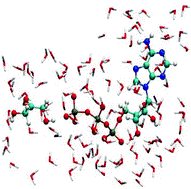A computational study of the phosphoryl transfer reaction between ATP and Dha in aqueous solution

Abstract
In this work, we studied phosphoryl transfer reactions, which are ubiquitous in biology and play critical roles in processes such as energy and signal transduction, as well as the replication of genetic material. Specifically, we focused on the generation of dihydroxyacetone phosphate (Dha-P), an intermediate in pyruvate synthesis and an essential building block in nature, which can be produced from free dihydroxyacetone (Dha) through the action of dihydroxyacetone kinase. We analyzed the reference uncatalyzed reaction in solution to establish the foundations of the chemical reaction and to identify the most suitable computational method for describing this electronically complex process. Using quantum mechanics/molecular mechanics (QM/MM) Molecular Dynamics (MD) simulations, we investigated the phosphorylation reaction mechanism between adenosine triphosphate (ATP) and Dha in aqueous solution. The QM subset of atoms was described using semi-empirical and DFT methods. Our results revealed a strong dependence on the level of calculation, which must be considered in future studies of the enzyme-catalyzed reaction. Specifically, we found that PM3/MM yielded lower free energy barriers and a less endergonic process compared to AM1d/MM and PM6/MM methods. However, the concerted pathway was not identified with the PM3/MM combination of potentials.